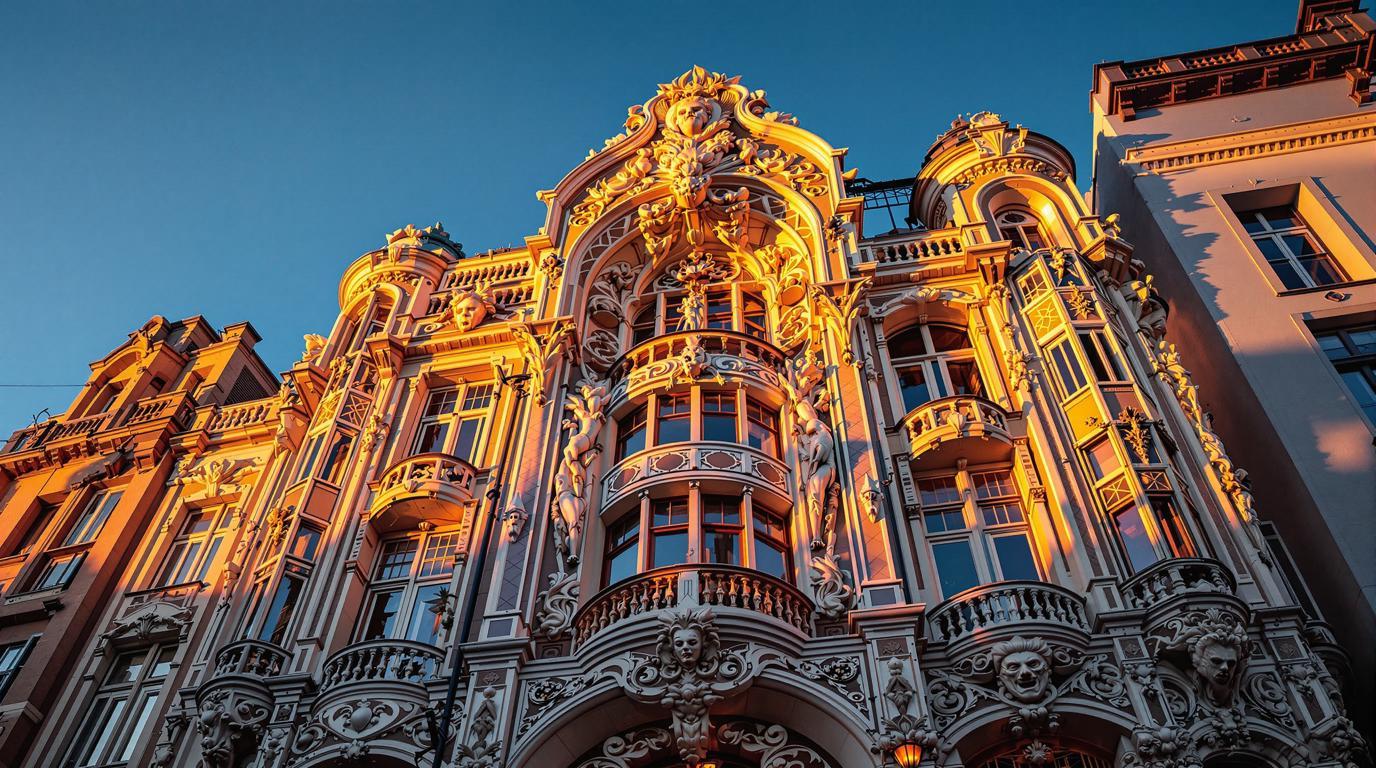Riga’s Art Nouveau facades glow golden in the Baltic sunset, showcasing the world’s richest collection of this ornate architectural style. While Paris and Barcelona flaunt their Art Nouveau treasures, Latvia’s capital quietly houses over 700 such buildings—the highest concentration on Earth. This medieval-meets-modernist gem remains Europe’s best-kept secret, where dragons and mythological creatures peer down from century-old buildings as cobblestones echo with a thousand years of history.
Where medieval charm meets Art Nouveau splendor
Riga’s UNESCO-listed Old Town forms a medieval labyrinth where Gothic spires punctuate the skyline. The House of Blackheads, with its distinctive red-brick facade, stands sentinel over cobblestone squares that buzz with café culture. Just steps away, the newer districts showcase architectural opulence that rivals Edinburgh’s dramatic cityscape, but with far fewer tourists jostling for photos.
Alberta Street: The Art Nouveau runway
Nowhere is Riga’s architectural flair more evident than on Alberta Street, where buildings resemble fantastical wedding cakes adorned with sculptural goddesses, screaming masks, and mythological beasts. Local architect Mikhail Eisenstein created these masterpieces between 1901-1908, infusing buildings with symbolism that tells stories to those who know how to read them.
“Our buildings don’t just house people; they house dreams. Each facade tells a different story—you need only look up to read a century-old tale,” explains Anita Vanaga, Riga Art Nouveau Museum curator.
The Baltic markets that feed the soul
Riga Central Market occupies five massive Zeppelin hangars repurposed after World War I. Inside, vendors arrange pyramids of forest berries, amber-hued smoked fish, and black bread that tastes of distant centuries. Unlike touristy markets elsewhere in Europe, most shoppers here are locals stocking their kitchens with regional specialties like pickled garlic scapes and caraway cheese.
Hidden courtyards reveal Riga’s secret life
Between grand facades lie atmospheric courtyards accessible through narrow passages that many tourists walk right past. These hidden spaces offer glimpses into authentic Latvian life—laundry fluttering in the breeze, cats lounging on windowsills, and impromptu art installations that wouldn’t look out of place in Berlin’s hippest neighborhoods. The contrast with Europe’s sun-blessed tourist hotspots couldn’t be more striking.
The city that glows at blue hour
Photographers treasure Riga’s “blue hour” when medieval spires and Art Nouveau details become silhouetted against the cobalt Baltic sky. From St. Peter’s Church tower, watch as the Daugava River reflects city lights in ribbons of gold and silver. This spectacle rivals the glowing lagoons of tropical paradises but with a distinctly northern European ambiance.
Where nature meets ancient culture
Just 20 minutes from central Riga, pine forests and sandy Jurmala beaches offer nature escapes reminiscent of America’s most unusual national parks. Locals gather wild mushrooms and berries in autumn, while summer brings midnight swims during the season of white nights when darkness barely falls.
“We Latvians have nature in our blood. Even city-dwellers like me need to touch trees and feel sand between our toes regularly,” says Janis Ozolins, a local architect who designs tours highlighting Riga’s dual identity as urban showcase and gateway to wilderness.
The unexpected bioluminescence of the Baltic
Few visitors realize that during warm summer nights, parts of the Baltic coast near Riga display subtle bioluminescence. While not as dramatic as India’s glowing blue shores, this gentle blue sparkle surprises midnight beachcombers who wade into the chilly waters.
Beyond the postcard views
Riga rewards those who explore beyond the obvious landmarks. The Moscow District offers industrial-chic galleries in former factories, while wooden houses in Kalnciema Quarter showcase traditional Latvian architecture. Each neighborhood presents a different facet of this multidimensional city, where Soviet history, Baltic heritage, and contemporary European culture create an intoxicating blend unlike anywhere else.
In Riga, time feels wonderfully suspended between epochs—you might turn a corner to find yourself in a medieval trading square, then walk a block to admire Art Nouveau masterpieces that wouldn’t look out of place in Paris. Yet unlike its Western European counterparts, Riga offers this sensory feast without the crowds, allowing you to savor each historic layer at your own pace, as if the city had been preserved especially for your discovery.
